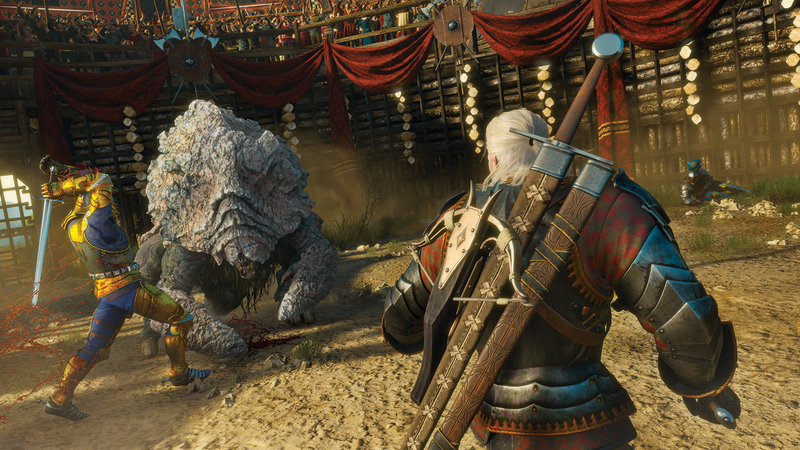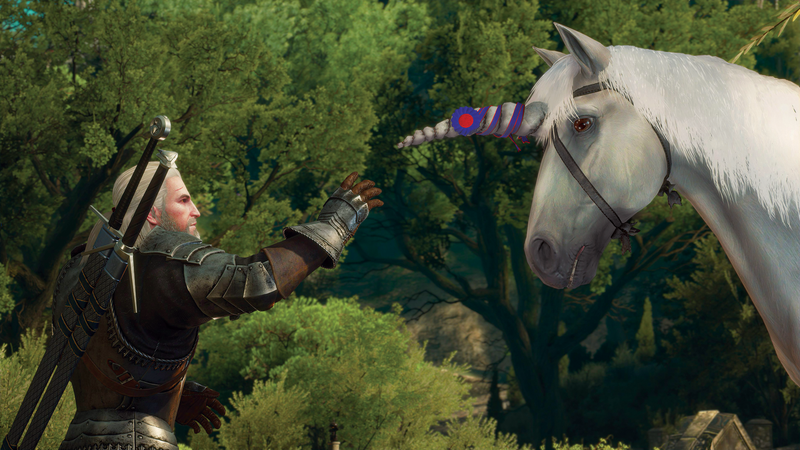It’s been well over a hundred and fifty hours of playtime as I approached CD Projekt RED’s final expansion to one of this generation’s best games. Having not played The Witcher 3: Wild Hunt since the release of the Hearts of Stone expansion back in October, I was eager to get back into this wonderful yet violent world. Although this is the last we will see of The Witcher franchise for a while, it’s a grand finale that not only delivers in overall content, but also provides our hero Geralt with a proper send off.
Geralt has his work cut out for him in Blood and Wine and the Duchess of Toussaint has personally requested his aid in solving the murders of three highly respected nobles. The story of Blood and Wine goes through many phases, but weaves a great tale of love and betrayal and what one would do for the those they truly love. As some may have guessed through the promotional art and trailers, Vampires take center stage in Blood and Wine. At first I was hesitant to this idea after facing them in the core game but my opinion on the matter changed rather quickly.

Unlike the Katakan and the Ekimmara vampires that we faced in Wild Hunt, Blood and Wine introduces us to the Higher Vampires. These higher Vampires are what we see in more popular culture. No, not the Twilight kind, but more in line with the large sharp claws and the bumpy forehead kind. I’m talking Jerry Dandrige and Amy Paterson from the original 1985 classic Fright Night Vampires; fast, powerful and easily the most enjoyable foes to battle in the franchise. The best part of the story is it brings back one of the coolest characters from the books long thought to be dead. Fans of the books will either enjoy this return like I was or will find plenty of issues with it.
Unlike the Hearts of Stone expansion, which kept you in the kingdom of Novigrad, CD Projekt RED has crafted an all-new, far off land for Geralt to explore this time around. Toussaint: The Land of Wine is exactly like it sounds: a land packed with farms and vineyards producing wine, it’s also one of the most lush and vibrant locations in The Witcher 3. Toussaint is also much different than Skellige or Novigrad; whereas those locations are dark and punctuated by crime, Toussaint is a far more peaceful environment.

Toussaint is mostly filled with rich nobles who constantly look down on Geralt or any foreigners who grace their land. This leads to some great conversations and writing. Geralt is constantly speaking in a sarcastic tone with the local guards who sound like glorious heroes from fairy tales or walking by the many vendors located in Toussaint, many of whom speak in a massively condescending tone. If you’ve ever been to a high profile restaurant and the the staff look at you like “you can’t afford to eat here,” you have a good example of what residents of Toussaint are like. Needless to say, I wanted to punch almost everyone I ran into in the face.
I also had a blast partaking in numerous entertaining activities, such as helping a knight in a tournament to win him the hand of a fair lady. You will also dress up and accompany the Duchess to a party where you will throw paint bombs to decorate a sheet on a wall while someone hilariously judges you. There is plenty more to do but I won’t spoil it for you.
@page
Blood and Wine is a hefty expansion, boasting over thirty hours of new content. In addition to the main story quest, The Witcher 3’s fantastic approach to side quests continues here. In short, I never had so much fun doing side quests as I did in Blood and Wine, including the base game. These quest ranged from more serious missions like solving the mystery of a haunted abandoned theater, to more comedic offerings like discovering who stole the penis of a famous statue, which had me in stitches throughout.

Other addictions include owning your own vineyard and new mutations to upgrade your skills. Owning your own vineyard is pretty much like owning your own home. You can make additions too, like adding a workbench and decorating your home with stands to display your armor along with an alchemy desk, and paintings to hang up. However, like everything else in the game it just costs way too much to upgrade, though it remains a nice addition nonetheless. Mutations require multiple skill points and high end mutagens to unlock. These mutations range from instantly killing any enemies you knock down using your Ard sign by freezing them, or reviving after being killed (this has a cooldown of course.)
These new mutations are better utilized for those in New Game + mode. The reason for this is simply because the materials required to unlock the new mutations are extremely hard to come by and those who are able to unlock all of them will breeze through the game without much challenge.
The expansion also includes the long awaited ‘Dyes’ functionality. Yep, you can now dye your armor different colors along with Grandmaster Witcher Gear, which give you special bonuses for having multiple pieces of a certain set. New weapons, and some fancy new armor can also be purchased from vendors. These are great additions but again cost a fortune to craft or even buy. For example, the components to craft the chest piece of the Wolf School can cost up to ten thousand crowns. That’s just one piece; imagine how much it would cost for the whole set. It’s like grinding your ultimate armor in an MMO, which is an extremely time consuming affair.
Although Vampires take center stage, Blood and Wine introduces various other creatures to face in battle. For example, new types of wraith’s haunt cemeteries and abandoned homes, while wild boars and panthers roam the fields searching for prey. Out of all the new additions however, the most annoying of enemies are the giant centipedes and acid spitting, man-eating flowers. These enemies like to bury themselves in the ground and pop out to attack you; they hit pretty hard and require great timing to dodge. As always, it’s a case of learning the correct strategy to beat them that will win you the day.
Outside of the large cost of new equipment I did run into various bugs. There were plenty of times when I would get stuck on things only to find out there was nothing there to get stuck on. Other issues saw me swingingly mindlessly at enemies, only to do zero damage even though my attacks are clearly connecting with my chosen target.
In conclusion, Blood and Wine adds a lot of new content that will keep people hooked from start to finish. Toussaint is a beautiful location to explore with its large open fields and landscapes leave me longing for a photo mode. The new enemies may prove frustrating at times, but will also force you to use your potions and signs in a more strategic way then you probably did before. Blood and Wine’s story sometimes feels like a dark fairy tale in its execution and the awesome fight cinematics are a joy to experience. Did I also mention the amazing final boss fight?

